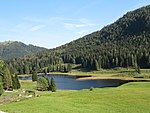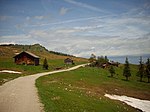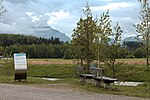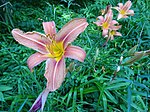List of landscape protection areas in the state of Salzburg
There are 53 landscape protection areas in Salzburg , which are designated on the basis of individual landscape protection area ordinances (as of January 2018).
| photo | Surname | ID | district | Location | description
|
surface | date |
|---|---|---|---|---|---|---|---|
| Ant lake | LSG000001 | Hallein |
Abtenau location |
The ant lake is an idyllic small lake embedded in a forest area. Its specialty is the harmonious contrast between the water surface and the surrounding green forest belt. Due to the natural fluctuations in the water level, the lake is characterized by structurally rich shore zones. | 106.69 ha | 10/01/1971 | |
| Egelsee near Abtenau | LSG00002 | Hallein |
Location |
The Eglsee (Egelsee), a silting lake , is embedded in a hollow with a wide belt of reeds, followed by a sedge swamp and wet meadows. The still relatively original meadow landscape was drained in the east and a spruce monoculture was planted. The wet meadows are sometimes still mowed by hand and show an extraordinary variety of rare plants of the wet and bog vegetation, such as. B. numerous orchid plants. The amphibians include grass and water frogs , birds include the little grebes, reed bunting, whinchat and the like. a. | 126.15 ha | 10/01/1971 | |

|
Seewaldsee | LSG00003 | Hallein |
Sankt Koloman location |
The lake, located in a basin between alpine meadows and commercial forests, has silting zones , moor areas and litter meadows . The area is well developed thanks to an extensive network of hiking trails. The yellow pond rose , sundew , eyebright and whistle grass can be found in the accompanying sedge belt and litter meadows, swinging lawns and moor / swamp areas . | 143.73 hectares | 09/01/1965 |

|
Wiestalsee | LSG00004 | Hallein |
Location |
The Wiestal reservoir in the deeply cut Almbach valley is a popular wild bathing area. It is surrounded by mixed forest, in the north there is a silting zone of the flowing Weißbach. The quarry forest-like silting zone has willow, alder, reeds and sedges. In the area of the dam above the main road is a small colony of gray herons . There are also mallards and tufted ducks, coots and wagtails in the area of the reservoir. | 570.67 ha | 08/27/1960 |
| Eibensee | LSG00005 | Salzburg area |
Location |
The mountain lake, which is embedded in limestone mountains, has steep steps and natural bank areas. The area is accessed by forest roads and is ideal for relaxing hikes. The surrounding vegetation is a spruce-fir-beech forest area . | 127.76 hectares | 08/26/1971 | |
| Filblingsee | LSG00006 | Salzburg area |
Location |
The lake lies in a karst depression . It is surrounded by commercial forests and has an interesting silting and floating leaf zone . The natural landscape is well developed through hiking trails. The surrounding commercial forests are trimmed with spruce, beech and occasionally fir. To the northwest, in the wet lower slope, an alder forest extends almost to the shore area. The silting and floating leaf zone has reeds and sedges. Occurrence of the yellow pond rose . | 107.92 ha | 08/26/1971 | |

|
Hintersee | LSG00007 | Salzburg area |
Faistenau location |
342.95 ha | 04/12/1941 | |
| Lugingersee | LSG00008 | Salzburg area |
Location |
The siltation zones of the two moor lakes Luginger See and Ragingersee are located in the heavily structured, hilly Alpine foothills. The lakes are surrounded by natural and cultural landscapes, consisting of agricultural meadows, forests and small hamlets. | 115.41 ha | 08/26/1971 | |

|
Wallersee | LSG00009 | Salzburg area |
Location |
12 km² | 08/06/1957 | |
| Böndlsee | LSG00010 | St. Johann |
Location |
The Böndlsee (also obsolete Pendlsee ) is located in a natural hollow on the low mountain range that accompanies the Salzach Valley. The lake is embedded in the rural cultural landscape and has a swinging lawn on the west side (transition moor, siltation zone), while the rest of the shore zone consists of meadows with small water inlets. The Böndlsee offers a high recreational value due to the use of swimming in natural or cultural landscapes. The transitional moor shows typical plant species of the moor vegetation with peat moss , downy birch , sedges and sundew. The dominant bird is the mallard. | 102.55 ha | 08/06/1957 | |
| Hakarsee | LSG00012 | St. Johann |
Untertauern location |
The Hakarsee is a secluded Karsee , in the area around there is extensive pasture-influenced spruce-larch mountain forest and dwarf shrub heaths . The extensive alpine management creates an alpine cultural landscape, which in connection with the natural landscape of the lake results in a particularly scenic beauty. In addition to patches of alpine vegetation, there are dwarf shrub heaths with alpine roses and blueberry plants. Down the slope follows loose forest with partly very old spruce and larch stands. The ptarmigan , black redstart and kestrel can be found in the higher elevations of the protected area ; in the transition to the forest there are species typical of the coniferous forest such as willow , crested and coal tit and the crossbill . | 91.32 ha | 08/26/1971 | |

|
Oberhüttensee | LSG00013 | St. Johann , Tamsweg |
Location |
86.38 ha | ||

|
Tappenkarsee | LSG00016 | St. Johann |
Location |
236.45 ha | ||

|
Jägersee | LSG00018 | St. Johann |
Location |
The almost untouched silting zone on the southern shore of the lake, which characterizes the landscape, extends 80 m inland. On the valley flanks there are pastures, in between forest areas with spruce and larch. Sedge and cotton grass can be found on the bank . The lake has an important fauna of small animals. | 135.68 ha | 08/28/1960 |

|
Hundsteinsee | LSG00023 | Zell am See |
Bruck an der Großglocknerstrasse location |
The subalpine Karsee in the Dientener Mountains lies below the 2117 m high Hundstein at an altitude of 1891 m . He is known for the traditional rangings that take place in the vicinity every year . | 101.71 ha | 08/01/1971 |
| Aigner Au | LSG00026 | Salzburg |
Salzburg location |
The Aigner Au is a remnant of the formerly large, diverse meadow landscape that accompanied the Salzach . The forest is a recreational area for the residents of the city of Salzburg. The dominant trees of this hardwood alluvial forest are ash , sycamore maple , winter linden , gray alder , sycamore elm and common oak . The high proportion of dead wood is remarkable . In spring, the typical lowland forest species bloom Yellow Star , Blue Star and spring snowflake . | 11.28 ha | 09.09.1976 | |
| Brucker Zeller Moos | LSG00027 | Zell am See |
Bruck an der Großglocknerstrasse location |
The moss was repeatedly flooded during high water. The moss has changed due to the drainage and straightening of the Salzach . The surrounding wet meadows are used intensively today. | 24.24 ha | December 16, 1975 | |
| Bundschuhtal | LSG00028 | Tamsweg |
Location |
The Bundschuhtal in the Lungauer Nock area , a high mountain valley in the south-east of Salzburg, is characterized by gentle terrain . The tri-border region of Salzburg, Carinthia and Styria is marked by the Königstuhl mountain . The Bundschuhtal was once a vast mining area (iron ore) that was finally closed at the beginning of the 20th century. The Bundschuhtal is rich in alpine pastures and has a well-developed network of trails. In 1977 the Rosanin nature reserve was removed . | 22 km² | 05.10.1973 | |

|
Gastein Valley | LSG00029 | St. Johann |
Location |
This protected area consists of the Kötschachtal, the Anlauftal and the Naßfelder Tal . It is very well developed for tourism. Sportgastein is known for winter sports, while the natural, rear Nassfeld is used for hiking in summer. In 1983, when the Hohe Tauern National Park was relocated, the nature reserve was reduced in size. | 44 km² | 05/29/1978 |
| Göll-Hagen-Hochkönig-Steinernes Meer | LSG00030 | Hallein , St. Johann , Zell am See |
Location |
Kuchl , Golling adS ; Throwing ; Mühlbach aH : Lofer , Saalfelden a.St.M , St. Martin bL ;
7 additional areas to ESG / NSG Kalkhochalpen ( AT3211012 / ESG00009 , 00012 ) |
37 km² | 09/15/1953 | |
| Felbertal Ammertal Dorferöd | LSG00031 | Zell am See |
Location |
The protected area extends over the Felbertal, Dorferöd and Ammertaleröd. The Felbertal , an alpine side valley of the Salzach valley , was formed by the Felberbach and rises to the Hintersee at the end of the trough. Above the end of the valley lies a high trough, a glacial landscape. Dorferöd and Ammertaleröd are forest areas with spruce and stone pine stands. | 98 km² | 09/09/1960 | |
| Hüttschlager valley ends | LSG00032 | St. Johann |
Location |
The Hüttschlager valley ends of the Großarler Ache , the Schöder, Hubalm and Reitalpental show hardly any anthropogenic influences. The landscape is characterized by numerous waterfalls. | 35 km² | 06/13/1978 | |

|
Kapuzinerberg | LSG00033 | Salzburg |
Salzburg location |
The settlement of the ridge of the Kapuzinerberg goes back to prehistoric times, during the Thirty Years War the mountain was incorporated into the defensive belt of the city of Salzburg . Today the Kapuzinerberg is a local recreation area for the people of Salzburg. The extensive forest areas are equipped with a well-developed network of paths, along the old city fortifications there are views of the old town and the fortress . The plateau is largely covered with beech forest. Various alpine plants ( auricles , alpine rush ) thrive in the north-facing, shady, cool rock walls , while a species-rich mixed hardwood and deciduous forest thrives on the southern flanks of the mountain. The old ponds are spawning waters for rare amphibians. Notable breeding birds are the common raven and the eagle owl . A group of chamois has existed on the mountain since 1952 . | 75.46 ha | 09/05/1973 |
| Königsleiten-Salzach origin-Nadernach | LSG00034 | Zell am See |
Location |
The area in the westernmost part of the Salzburg Slate Alps is characterized in the upper areas by extensive alpine pastures, below 1900 m by spruce-rich mountain forests. Below the Salzachgeier lies the origin of the Salzach . | 35 km² | December 25, 1964 | |
| Lahn valley | LSG00035 | Zell am See |
Location |
The valley west of Mitterhofen , which was covered with glacial layers and laid with moraine material , no longer had any drainage. The onset of water damming led to the formation of bog. Despite human use, the characteristic bog is still preserved through drainage at the edge . The disturbed bog has the typical bog vegetation with species such as peat moss , various sour grasses , sedges and cotton grass . In the wetland there are a large number of butterflies and a rich bird fauna (such as brown ella , thrush ). | 209.55 hectares | 02/27/1976 | |
| Lantschfeld-Oberes Murtal-Oberes Zederhaustal | LSG00036 | Tamsweg |
Location |
The natural landscape is in the upper Mur and Zederhaus valleys in the Niedere Tauern . The subsoil, which has been folded and scaled by tectonic processes, is covered by forest in the lower area, above is a high valley system of alpine meadows , interspersed with karen and cirque lakes. The region offers rich hiking and ski touring opportunities. The numerous slopes with pasture meadows and subalpine spruce forest are followed by larch-stone pine forest mixed with dwarf shrub stands . Mountain pines settle on the chalky subsoil . At the end are alpine mats that merge into the rocky region with pioneer vegetation . A diverse plant landscape grows on limestone and silicate soils. Monkshood , gentians , soldanelle , clove root and bilberry can be found along the way . In addition to the typical forest fauna with red and roe deer, fox, badger and mountain hare is available in the areas loosened Auer - and black grouse and golden eagles. There are around 320 different species of butterflies. | 202 km² | 04/05/1941 | |

|
Leopoldskroner pond | LSG00037 | Salzburg |
Salzburg location |
The pond, which can be traced back to the late Middle Ages, was part of the extensive palace gardens of the rococo palace Leopoldskron, which was built later . The water was used for fish farming. After 1820 it was also used as a swimming school and soon also for ice and reed extraction . In the late 19th century the pond became an important local recreation area, which is often used for ice skating and curling in winter . On individual sections of the bank and on the three islands, swamp vegetation and reed communities with the common iris can be found. Mallard and mandarin ducks , black-headed gulls and coots swim on the lake . | 81.33 hectares | 09/16/1976 |

|
Postalm | LSG00038 | Salzburg area , Hallein |
Location |
Almwirtschaft has been practiced on the Postalm for more than 300 years; horses used to graze here for the post office. The little cut up high plateau in the Osterhorn group with its marly layers of Oberalmer is subject to a slight weatherability, the landscape is therefore characterized by gentle hills. The Postalm is a popular recreational and hiking area. In addition to pastures, turf and storage corridors , there are also grass grass , blue grass , gold oat grass , rhododendron heather and peat moss communities . There are gorge and spruce forests as well as pine bushes in the woods . Black grouse and capercaillie as well as tawny owls , buzzards and golden eagles make their rounds in the open wooded areas . Alpine newt and common frog occur in the wetlands. The rabbit and the fox say goodnight to each other. | 14 km² | 01/01/1976 |
| Rossfeldstrasse | LSG00039 | Hallein |
Location |
The alpine pasture area on the northern foothills of the Göll , which separates the Hallein basin from the "basin landscape" of the Berchtesgaden basin or the geomorphological unit of the Berchtesgaden basin , is crossed by the Rossfeldhöhenringstrasse . The area is a popular destination for summer and winter sports enthusiasts. | 49.73 ha | 08/02/1960 | |

|
Urstein | LSG00040 | Hallein |
Location |
99.9 ha | ||

|
Obertauern | LSG00041 | St. Johann |
Untertauern location |
42 km² | ||

|
Mönchsberg - Rainberg | LSG00042 | Salzburg |
Location |
83.84 ha | ||

|
Lake Zell | LSG00043 | Zell am See |
Location |
702.1 ha | ||
| Oberpinzgau National Park Apron LSV | LSG00044 | Zell am See |
Location |
47 km² | |||
| Rabenstein Kellau | LSG00045 | Hallein |
Location |
440.38 ha | |||
| Schafberg - Salzkammergut lakes | LSG00046 | Salzburg area |
Location |
56 km² | |||

|
Leopoldskroner moss | LSG00047 | Salzburg |
Salzburg location |
two sub-areas also: Protected Green Belt (REK) ; adjacent: LSG Untersberg (00051) | 656.05 hectares | |

|
Irlacher Au | LSG00048 | Salzburg area |
Location |
167.15 ha | ||

|
Plainberg | LSG00049 | Salzburg , Salzburg area |
Location |
198.49 ha | ||

|
Siezenheim Au | LSG00050 | Salzburg area |
Location |
Kleßheim Palace and the surrounding area, also listed ensemble and garden ( list entry ), | 146.2 ha | |
| Untersberg | LSG00051 | Salzburg area |
Grödig , Großgmain , Wals-Siezenheim location |
also PSG 00001 ; contain: NAP Untersberg ( 00001 ); adjacent: ESG u. LSG Untersberg-Vorland ( FFH AT3227000 / 00017 , 00063), LSG Leopoldskroner Moos (00047), MAB Berchtesgadener Land (development zone ) in Bavaria | 44 km² | ||
| Salzburg-South | LSG00052 | Salzburg , Salzburg area , Hallein |
Location |
11 km² | |||

|
Fuschlsee | LSG00053 | Salzburg area |
Location |
658.65 ha | ||

|
Twenger Au | LSG00054 | Tamsweg |
Location |
131.66 ha | ||

|
Salzachsee Saalachspitz | LSG00055 | Salzburg |
Location |
The recreation area is characterized along the Saalach and Salzach rivers by a wide border of hardwood alluvial forest , but also by the park landscape around the salt axes . On both sides of Glanbach and Mühlbach with their naturally preserved banks, there are meadows and fields loosened up by hedges and woods. The dominant tree in the alluvial forest is the ash . In addition to a diverse bird life, there are also trees felled by beavers several times along the streams. | 184.41 ha | 06/30/1967 |

|
Goldegger See | LSG00056 | St. Johann |
Location |
The area around the lake, located on a terrace above the Salzach Valley, is glacial. The plateau was covered in places with moraines and was partially underlain by interglacial gravel. This is how hollows were created, including Lake Goldegger. The cultural landscape is an alternation of forest, meadow, pasture and field. Climatic advantages allow field management. | 115.77 ha | 08/06/1957 |

|
Grossglockner High Alpine Road | LSG00057 | Zell am See |
Location |
717.47 hectares | 08/06/1957 | |
| Tennengebirge | LSG00058 | St. Johann |
Location |
48 km² | |||
| Lower Tauern | LSG00059 | Tamsweg |
Location |
197 km² | |||
| Dream lakes | LSG00060 | Salzburg area |
Location |
15 km² | |||
| Gerhardstein-Hintertal-Weißbacher-Almen | LSG00061 | Zell am See |
Location |
28 km² | |||

|
Seetal lake | LSG00062 | Tamsweg |
Location |
The landscape is located on a watershed between the glacial heights of the Überling and the Sauerfeldberg , at the foot of the Gstoder and, according to pollen studies, has been inhabited for 5000 years. In the core area is the Seetal lake with its wide swinging lawn belt . A tributary was relocated a few years ago. The lake itself was dammed by an alluvial cone. The landscape protection area bordering the core area is characterized by commercial forests and wastelands . The area is well developed.
The open water is known for its variety of ornamental algae , on the east bank there is a population of gray alder , the other peripheral areas have the largest population of vibrating lawns and moors with different types of vegetation in Austria. Due to the steep slopes of the Schwarzenbach Forest in the south, the vegetation of the southern bank is exposed to extreme climatic conditions due to winter, night-time cold accumulations, while the northern part is strongly heated by solar radiation. The rare seven-pointed star occurs in the area. In the spruce-fir forest , which borders the sensitive area of the core zone, there are living raised bogs and pine bogs . The wetland with the adjacent meadow and woody structures offers a habitat for a large number of animal species. Bats use the rock and tree caves as well as old wood and various wood structures. In the forest area are black woodpecker and grouse ( hazel - grouse ) ago. The wet areas are spawning waters for amphibians (newt, common toad , common frog ). Lizard, grass snake and adder have been observed in reptiles . The puller little bittern , sandpiper and little grebe rest here. |
214.54 hectares | |
| Untersberg foreland | LSG00063 | Salzburg area |
Großgmain , Wals-Siezenheim location |
also ESG ( FFH AT3227000 / 00017 ); adjacent: LSG Untersberg (00051),
MAB Berchtesgadener Land (development zone) in Bavaria |
193.18 ha |
| Photo: | Photography of the natural monument. Click the photo generates an enlarged view. There are also two symbols:
|
||||
| Surname: | Designation of the natural monument according to official sources | ||||
| ID | Identifier | ||||
| Location: | The municipality and, if available, the address are given. The cadastral community (KG) and the property number are listed below. By calling up the link Location , the location of the monument is displayed in various map projects. | ||||
| description | Brief description of the natural monument | ||||
| surface | Area of the natural monument in hectares (ha) | ||||
| date | Date or year of protection |
Web links
- Landscape protection areas , in the protection area inventory at salzburg.gv.at. Descriptions primarily based on the official description.
Evidence and Notes
- ↑ Lofer and St. Martin are officially indicated, but the section is only located in Saalfelden
- ↑ a b Federal Agency for Nature Conservation : Landscape profile - 1600 Berchtesgaden Alps , last change: March 1, 2012, online at bfn.de
- ↑ For the " geomorphological unit of Berchtesgaden valley basin" see Planning Office Steinert, Landschafts + Ortsplanung (D-83236 Übersee): Markt Berchtesgaden - Land Use Plan with Landscape Planning , Chapter: 2.6 Landscape as a Protected Property ; Environmental reports from March 6, 2014 to March 6, 2016, PDF file p. 16 of 48 pages; In addition, multiple use of the terms “valley basin” and “valley basin communities” from p. 3, online at gemeinde.berchtesgaden.de
- ↑ a b REK 2007 declaration 'Geschützes Grünland' , plan number: 2.05 Green belt for the Salzburg metropolitan area - area of the city (pdf; 2.0 MB), both Salzburg stadt-salzburg.at → urban planning
- ↑ Untersberg plant protection area in the nature reserve book of the State of Salzburg
- ↑ Untersberg Nature Park in the nature reserve book of the State of Salzburg
- ↑ Untersberg-Vorland - European Protection Area Ordinance, Untersberg. Landscape Protection Ordinance 1981, Plant Species Protection Ordinance . Sbg LGBl 2007/59 ( ris.bka , pdf)